One of the main attractions of technical wreck diving is the opportunity to explore the history and mystery of sunken ships and other structures. These underwater time capsules offer a glimpse into the past and a chance to discover artifacts and treasures that have been lost for decades or even centuries. In addition to the historical and archaeological significance of these sites, technical wreck divers also enjoy the thrill of penetration diving, the challenge of navigating and mapping the wreck, and the opportunity to see marine life that has made the wreck its home. Diving wrecks requires specialized training, equipment, and experience. Here are some key steps and equipment that are needed for wreck diving:
-
Training: Wreck diving is considered a more advanced form of diving and requires specialized training. Many dive organizations, such as TDI and SSI, offer wreck diving courses that teach divers the skills and knowledge needed to safely and responsibly explore wrecks. These courses typically cover topics such as wreck diving regulations, safety procedures, navigation, and penetration diving.
-
Equipment: Wreck diving requires specialized equipment to ensure safety and comfort. Some of the essential equipment for wreck diving includes:
-
a full wetsuit or drysuit: to protect against cuts, scrapes, and the colder water found at deeper depths
-
a diving flashlight: for exploring the inside of wrecks and illuminating the way
-
a dive reel or line: to help divers navigate the wreck and mark the way out
-
a dive knife or cutting tool: for cutting away any entanglement
-
a dive computer or depth gauge: to monitor depth and time, and avoid decompression sickness
-
a compass: for navigation and maintaining a sense of direction
-
a signaling device: such as a whistle or dive slate, to communicate with your dive partner
-
a backup dive light and a dive watch with a timer
-
a diving torch, backup dive light, and dive watch with a timer
-
a back-up air supply, in case of emergency, such as a pony bottle or a spare scuba cylinder
-
a dive partner: wreck diving is generally considered a team sport, and it is recommended to always dive with a partner.
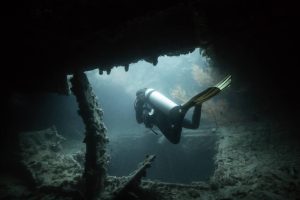
-
Planning and Preparation: Before diving a wreck, it's important to plan and prepare thoroughly. This includes researching the wreck, including its history and location, and obtaining any necessary permits or permissions. Divers should also review diving tables or use a dive computer to plan the dive and ensure that they stay within safe limits for depth and time.
-
Dive Procedures: Once in the water, divers should follow established dive procedures to ensure safety and minimize impact on the wreck and its environment. This includes staying with a dive buddy, using a dive reel or line to navigate, and avoiding touching or removing artifacts. Divers should also be aware of their air supply and use their dive computer or depth gauge to monitor their depth and time.
-
Emergency Procedures: Finally, it's important to be prepared for emergencies and to have a plan in case of an accident. This includes having a dive buddy, carrying a signaling device, and knowing the location of the nearest emergency services.
Wreck diving is an exciting and challenging type of diving that offers the opportunity to explore history, marine life and uncover artifacts and treasures that have been lost for decades or even centuries. It is crucial to have the right training, equipment and to plan, prepare and follow the established dive procedures in order to dive safely. With the right preparation and training, wreck diving can be a rewarding and unforgettable experience Southeast Asia is home to a variety of shipwrecks and other underwater structures that offer excellent opportunities for wreck diving. Here are some of the best wreck diving sites in Southeast Asia:
USS Liberty , sank in 1944
-
The Liberty shipwreck in Bali, Indonesia: This American ship was built in the 1940s and was sunk by the Japanese during World War II. The wreck now lies in about 30 meters of water and is home to a variety of marine life, making it a popular spot for both recreational and technical divers. We at Seapixels frequent this wreck and the resort we are staying at Pebbles and Fins offers both leisure and technical diving.
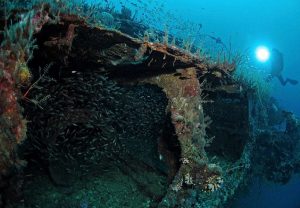
I 66 Japanese Submarin, sank in 1944
-
The I-66 submarine in Sipadan, Malaysia: This Japanese submarine was sunk by the Allies during World War II and now lies in about 40 meters of water. The I-66 is considered one of the best wreck dives in Southeast Asia and offers a unique opportunity to explore the inside of a submarine.
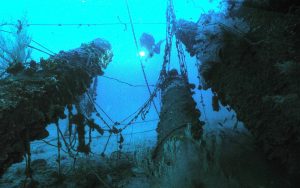
HMS Repluse, sunk in 1959
-
The HMS Repulse in Tioman Island, Malaysia: This British merchant ship was sunk by the Japanese during World War II and now lies in about 30 meters of water. The wreck is home to a variety of marine life and offers a glimpse into the history of the war in Southeast Asia.
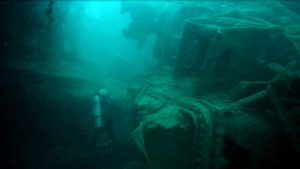
Australian National Maritime Museum HMAS Perth dive 2017
-
The HMAS Perth in Indonesia: This Australian cruiser was sunk by the Japanese during World War II and now lies in about 30 meters of water. The Perth offers a variety of penetration opportunities, including the ship's engine room and gun turrets.
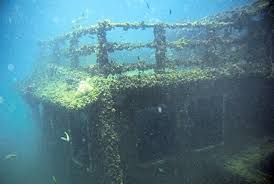
USS Salute, sunk in 1942
-
The USS Salute in Subic Bay, Philippines: This American mine-laying ship was sunk by the Japanese during World War II and now lies in about 30 meters of water. The Salute offers a variety of penetration opportunities, including the ship's engine room and bridge.

The S.S. Thorfinn in Mergui Archipelago,Myanmar
-
The S.S. Thorfinn in Mergui Archipelago,Myanmar: This British merchant ship was sunk by the Japanese during World War II and now lies in about 30 meters of water. The Thorfinn offers a variety of penetration opportunities, including the ship's engine room and holds.
These are just a few examples of the many incredible technical wreck dive sites that are available around the world. Each site offers its own unique challenges and rewards, and many technical divers choose to specialize in specific types of wrecks, such as WWII ships, submarines, or planes.
Lang Tengah newly Submerged Plane
It's important to note that Technical Wreck Diving is a complex and challenging type of diving that requires extensive training, equipment, and experience. It is not recommended for novice divers and should only be attempted by divers who have completed the relevant training and have the necessary experience and skills. TDI Courses provides full extensive Wreck courses or plan your courses with us at Seapixels. We at Seapixels can start your journey into Wreck Diving with Sidemount and Nitrox. Drop us an email at Terence@seapixels.org for more details.
![]()
Technical diving is a type of diving that goes beyond the limits of recreational diving and requires specialized training and equipment. It involves diving in environments or at depths that are beyond the scope of recreational diving, and often involves the use of specialized gases and diving techniques. Technical diving can include a wide range of activities, such as cave diving, wreck diving, deep diving, and more. Technical diving requires a high level of skill, knowledge, and physical fitness, as well as a commitment to safety. It is not a pursuit for the casual or inexperienced diver, and requires extensive training and experience to master.Training for technical diving typically begins with an introduction to the basic concepts and principles of technical diving. This can include topics such as dive planning, gas management, decompression theory, and emergency procedures. From there, divers can progress to more advanced training, such as cave diving, deep diving, or wreck diving.
One of the key aspects of technical diving is the use of specialized equipment and gases. This can include the use of multiple tanks, which allow divers to carry a larger volume of gas and extend their dive time. It can also involve the use of specialized breathing gases, such as trimix (a mixture of oxygen, helium, and nitrogen), which can help divers to avoid the effects of nitrogen narcosis at deeper depths.
In addition to specialized equipment and gases, technical diving also requires a high level of planning and risk management. Divers must carefully plan their dives, taking into account factors such as depth, time, gas usage, and emergency procedures. They must also be prepared to deal with a wide range of potential emergencies, including out-of-air situations, equipment failures, and more.
Technical diving is not for everyone, and it requires a high level of skill, knowledge, and physical fitness. However, for those who are willing to put in the time and effort to master these skills, it can be an incredibly rewarding and exciting pursuit. Technical diving allows divers to explore the underwater world in ways that are not possible with recreational diving, and it can open up a whole new world of adventure and discovery.
We at Seapixels would love to bring you to explore the Technical world starting with Sidemount, Nitrox and Advanced Nitrox before we progress to other Technical Disciplines. Free Free to chat with us at Terence@seapixels.org or message us at +60163225555
![]()
Decompression sickness, also known as "the bends," is a potentially life-threatening condition that can occur when a diver ascends too quickly from a deep dive. It is caused by the rapid expansion of gases in the body, which can lead to a variety of symptoms including joint pain, skin rash, dizziness, and difficulty breathing. In severe cases, decompression sickness can result in paralysis, brain damage, and even death.Decompression sickness occurs when a diver spends a significant amount of time at depths greater than 40 feet, breathing compressed air. At these depths, the pressure is much greater than at the surface, and the body absorbs more nitrogen from the air. When the diver ascends, the pressure decreases and the nitrogen expands, forming bubbles in the body's tissues and blood. These bubbles can cause a variety of problems, depending on where they form. The most common symptoms of decompression sickness are joint pain and fatigue. These symptoms often occur in the elbows, shoulders, and knees, and can range from mild to severe. Other symptoms can include skin rash, dizziness, and difficulty breathing. In severe cases, decompression sickness can cause paralysis, brain damage, and even death. There are several factors that can increase the risk of decompression sickness, including the depth and duration of the dive, the type of diving equipment used, and the diver's physical condition. Divers who are older, obese, or in poor physical condition are at greater risk of developing the bends. In addition, diving at depths greater than 100 feet or diving for extended periods of time can increase the risk of decompression sickness.
To prevent decompression sickness, divers must follow proper dive procedures and use the correct equipment. This includes using a dive computer or dive tables to calculate the appropriate dive time and ascent rate, and using a dive watch or other device to monitor the dive. In addition, divers should avoid flying or traveling to high altitudes within 24 hours of diving, as the lower pressure at higher altitudes can cause gases to expand more rapidly.
If a diver does develop decompression sickness, it is important to seek medical treatment as soon as possible. Treatment for decompression sickness typically involves administering 100% oxygen and placing the diver in a hyperbaric chamber, which can help to reduce the size of the nitrogen bubbles and improve symptoms. In severe cases, the diver may need to undergo surgery to remove the gas bubbles. In conclusion, decompression sickness is a potentially life-threatening condition that can occur when a diver ascends too quickly from a deep dive. It is caused by the rapid expansion of gases in the body, and can lead to a variety of symptoms ranging from mild joint pain to severe paralysis and brain damage. To prevent decompression sickness, divers must follow proper dive procedures and use the correct equipment, and seek medical treatment if symptoms develop.
![]()
Buoyancy is an important aspect of scuba diving, as it determines how easily a diver can move through the water and control their depth. In simple terms, buoyancy is the ability of an object to float or sink in a fluid, such as water. When a diver is neutrally buoyant, they are able to hover in the water without sinking or rising, which allows them to move freely and conserve energy. There are several factors that affect a diver's buoyancy, including their body composition, the weight of their diving equipment, and the type of diving suit they are wearing. A diver's body composition can affect buoyancy because different tissues have different densities, with fat and muscle being less dense than bone. This means that a diver with a higher percentage of body fat may be more buoyant than a leaner diver.The weight of a diver's diving equipment, such as their scuba tanks, diving weights, and wet suit, can also affect buoyancy. A diver who is carrying too much weight may sink too easily, while a diver who is carrying too little weight may struggle to descend. The type of diving suit a diver wears can also affect buoyancy. Wet suits are made of neoprene, a synthetic rubber that is less dense than water. This means that a wet suit can provide some buoyancy to a diver, helping them to float more easily. However, wet suits can also trap small amounts of water inside, which can increase a diver's weight and decrease their buoyancy.
To control buoyancy while diving, divers can use a variety of techniques and equipment. One common technique is the use of diving weights, which are placed in pockets on the diver's weight belt or harness. Divers can add or remove weights to fine-tune their buoyancy, depending on the conditions of the dive. Another technique for controlling buoyancy is the use of a buoyancy control device (BCD), which is a piece of diving equipment that allows a diver to inflate or deflate a bladder of air to adjust their buoyancy. BCDs are worn on the diver's back and are connected to the scuba tank via a hose. By adjusting the amount of air in the bladder, a diver can make themselves more or less buoyant. In addition to these techniques and equipment, divers can also use proper breathing and finning techniques to control their buoyancy. Proper breathing involves exhaling as the diver descends and inhaling as they ascend, which can help to maintain a neutral buoyancy. Finning techniques, such as the frog kick or the flutter kick, can also help a diver to move through the water with greater control and efficiency. In conclusion, buoyancy is an important aspect of scuba diving that determines how easily a diver can move through the water and control their depth. There are several factors that affect a diver's buoyancy, including their body composition, the weight of their diving equipment, and the type of diving suit they are wearing. To control buoyancy, divers can use diving weights, BCDs, proper breathing and finning techniques, and other equipment and techniques. By mastering buoyancy, divers can enjoy greater control and freedom during their dives, and reduce the risk of accidents or injuries. We at Seapixels conduct regular buoyancy classes at the comfort of swimming pool where we can correct and advice all divers. Our methods of teaching is fun and quick to learn coming from 20 years of scuba experience. You'll definitely be correct weighted and your trimming and breathing will drastically improve as well. Just Drop us an email at terence@seapixels.org or message us at +60163225555 for more information on classes. Cheers